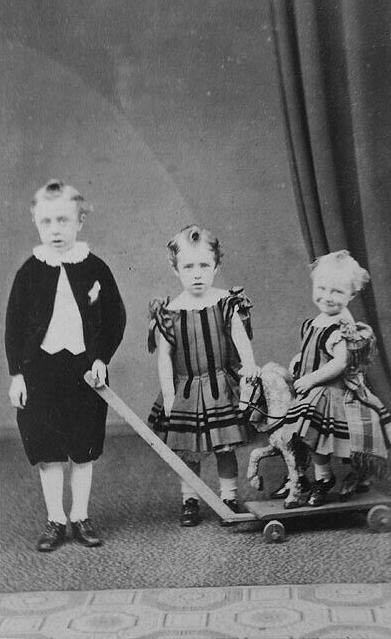
Figure 1.--This London CDV portrait shows fashions for youngerr boys anout 1870. Velvet was a popular fabric for younger boys. The boys look to be about 1-6 years old. It was common at the time for younger boys to wear dresses. |

|
Interestingly, English history economics was significantly affected by textile materials, primarily wool and cotton. Materials refers to the raw material used to weave fabrics. The meduieval English economy was in karge nmeasure based in the wool trade. At first, England exported wool to the weavers in the Low Countries. Thui area became the most ecomically valuable in Europe. And became contested by the great continental powers (France Austria/Germany, and Spain). England would fight to prevent its domination, by these powers. Gradually England developed her own weaving indutry. Clothing was very expensive for centuries because it was mostly made from wool, expepsive to produce, and the manual weaving technology. This began to change with the Industrial Revolution which began with the mass profuction of cotton trextiles with newly developed mnachinery. At the same time, the cotton gin in America made the production of cotton possible at a far lower price than wool. The Industril Revolution began with textiles, but would go on to create a great industrial economy. This greatly reduced the price of textiles and clothing. Other materials such as linnen and silk are of lesser importance. A wide range of textiles fabrics were developoed and produced.. Some of the most important included corduroy, drill, flammel, gaberdine, terrelyn, tweed, velvet, and others were used in boys clothing. In the 20th cebtury, synthertic fabrics were developed. It is often not possible to tell the material/fabric from available pohotography, but some information can sometimes be detected.
Interestingly, English history economics was significantly affected by textile materials, primarily wool and cotton. Materials refers to the raw material used to weave fabrics. The meduieval English economy was in karge nmeasure based in the wool trade. At first, England exported wool to the weavers in the Low Countries. Thui area became the most ecomically valuable in Europe. And became contested by the great continental powers (France Austria/Germany, and Spain). England would fight to prevent its domination, by these powers. Gradually England developed her own weaving indutry. Clothing was very expensive for centuries because it was mostly made from wool, expepsive to produce, and the manual weaving technology. This began to change with the Industrial Revolution which began with the mass profuction of cotton trextiles with newly developed mnachinery. At the same time, the cotton gin in America made the production of cotton possible at a far lower price than wool. The Industril Revolution began with textiles, but would go on to create a great industrial economy.
The Industrial Revolutiion greatly reduced the price of textiles and clothing. Other materials such as linnen and silk are of lesser importance. A wide range of textiles fabrics were developoed and produced.. Some of the most important included corduroy, drill, flannel, gaberdine, terrelyn, tweed, velvet, and others were used in boys clothing. Some of these fabrics were especially associted with boys' clothing, including corduroy, drill, flannel, and terryln were especially important in boys' clothing, insome cases school clothing. Children at the time did not have the large wardrobes that are common today. Thus school clothes were often a child's best clothes, unless the family ws well-to-do. There were school uniforms in Britain, but only in the orivate schools. In the 20th century, synthertic fabrics were developed. It is often not possible to tell the material/fabric from available photography, but some information can sometimes be detected.
Corduroy is a woven fabric. It is produced by twisted fibres to create a destinct tufted effect. Both cotton or wool can be used, but most cirduroy for children usd cotton. It is done in a range of thicknesses. It is a popular fabric for boys and prised for its hard wearing characteristics. It is especially important during the colder months. It’s often chosen for onformal wear, both pants and jackets. Some caos were done in corduroy. Manchester was know for corduroy. In the late-19th and early-20th century, inexpensive boys suits were avaiabke in corduroy.
Flannel is a softer woven fabric done in both wool and cotton. It was traditionally made in Wales and dates to the 16th century. Flannel is commonly sed to make lightweight trousers, tartans, and informal shirts. Most blazers were done in flannel.
Gabardine is consudered a a British fabric and is relativeky new. Iit was invented Thomas Burberry, a very reecognizable name in fashion (1870s). True gaberdine is made from worsted wool fibres and woven as a regular twill. Gabardine is a particularly hardwearing woollen fabric, commonly used fir suits. Gaberdine overcoats were common for boys.
Terelyn worsted wa a modern fabric which largely replaced flannel for shool shoirts and trousers, most commonly done in grey
Tweed mnay be the most British of fabrics. It is cerainly strinly assicizted with British tailoring. It is more commnly used in adult than boys garments. It is rough, closely woven woollen fabric that is especially noted for its hard wearing, durable characteristics. It is often produced in twill or herringbone patterns in a wide range of colors. It is most commonly used for outerwear because of its hardwearing and water-resistant fearures.
Velvet is a luxury fabric initially dome in silk. By the 19th century it was more commonly a silk-cotton blend. Luxury fabrics are not commonly associated with boys' wear, but we notice velvet being used for younger boys' wear such as Fauntleroy suits. We also see velvet being used as trim on better boys's wear.
Navigate the Boys' Historical Clothing Web Site:
[Return to the Main English pages]
[Return to the Main European country pages]
[Introduction]
[Activities]
[Biographies]
[Chronology]
[Clothing styles]
[Countries]
[Essays]
[Bibliographies]
[Contributions]
[FAQs]
[Glossary]
[Images]
[Links]
[Registration]
[Tools]
[Boys' Clothing Home]
